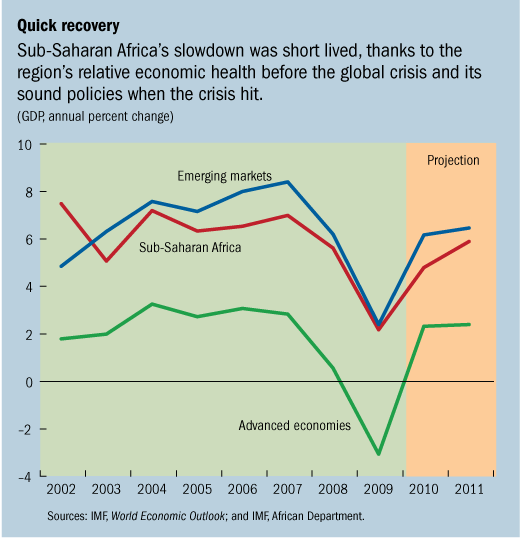
Typical street scene in Santa Ana, El Salvador. (Photo: iStock)
IMF Survey: Africa's Growth Set to Bounce Back After Short Slowdown
April 23, 2010
- Economic recovery in Africa now under way after global financial crisis
- Higher government spending, lower interest rates buttressed activity
- Rebound in global demand, commodity markets helped restore exports
Economic growth in most sub-Saharan African countries is expected to rebound this year after a short slowdown, playing off the revival in global economic activity, an IMF report said.

Fabric market in Nairobi, Kenya: Africa’s low-income countries proved fairly resilient to impact of global economic downturn (IMF photo)
REGIONAL ECONOMIC OUTLOOK
The IMF’s Regional Economic Outlook for sub-Saharan Africa said the sub-continent’s output is projected to expand by some 4¾ percent this year, up from 2 percent in 2009.
“Provided the global economy continues to improve, growth in the region should accelerate further still to 5¾ percent in 2011. In essence, the expectation is that growth in most countries is set to bounce back, albeit to rates a little shy of those that prevailed in the mid-2000s,” the report said.
The brevity of the region’s slowdown owes much to the relative health of the region’s economies in the mid-2000s, and the countercyclical macroeconomic policies that were pursued in many countries. Export earnings also benefited from the quick recovery in global economic activity and commodity markets following the world financial crisis (see chart).

The countries most severely affected by the global financial crisis were sub-Saharan Africa’s middle-income and oil-exporting countries, which are more closely integrated into the world economy. The region’s low-income countries, on the other hand, proved fairly resilient to the global downturn, with some fragile economies actually experiencing a small acceleration in output growth in 2009.
Policy action sustained activity
Nearly two-thirds of the countries experiencing a slowdown were able to increase government spending to buttress economic activity in 2009. Health and education spending rose in real terms in 20 of the region’s 29 low-income countries. Policy interest rates were also reduced.
External financing proved to be much less of a constraint than feared. Private financial inflows were not as disrupted as much as elsewhere, largely because of the relatively high proportion of foreign direct investment in these flows in sub-Saharan Africa. Remittances also fell only slightly. And official financing flows increased, in response to the crisis.
Longer-term costs
Nevertheless, job losses and reduced employment opportunities have affected millions of households. With government-provided social safety nets virtually nonexistent, both the cash impact and the long-term nonmonetary consequences of losing job openings have been severe.
The experience of previous economic slowdowns suggests that setbacks can be expected in all areas of human development, implying that slower progress can be expected toward the United Nations Millennium Development Goals.
A key issue going forward is the extent to which the global downturn and the uncertain prospects for the global economy might reduce the region’s future economic growth. Encouragingly, there is not much sign in sub-Saharan Africa of the disruptions to financial systems or massive expansion of public sector balance sheets that have shown up in many advanced and some emerging economies. So sub-Saharan Africa is more likely to be affected indirectly, with slower growth in the advanced and some emerging market countries dampening demand for and prices of Africa’s exports .
For now, the world economy is expected to show a sustained if moderate recovery. Providing this holds, prospects are good for growth rates in sub-Saharan Africa to rebound close to precrisis levels in most countries.


